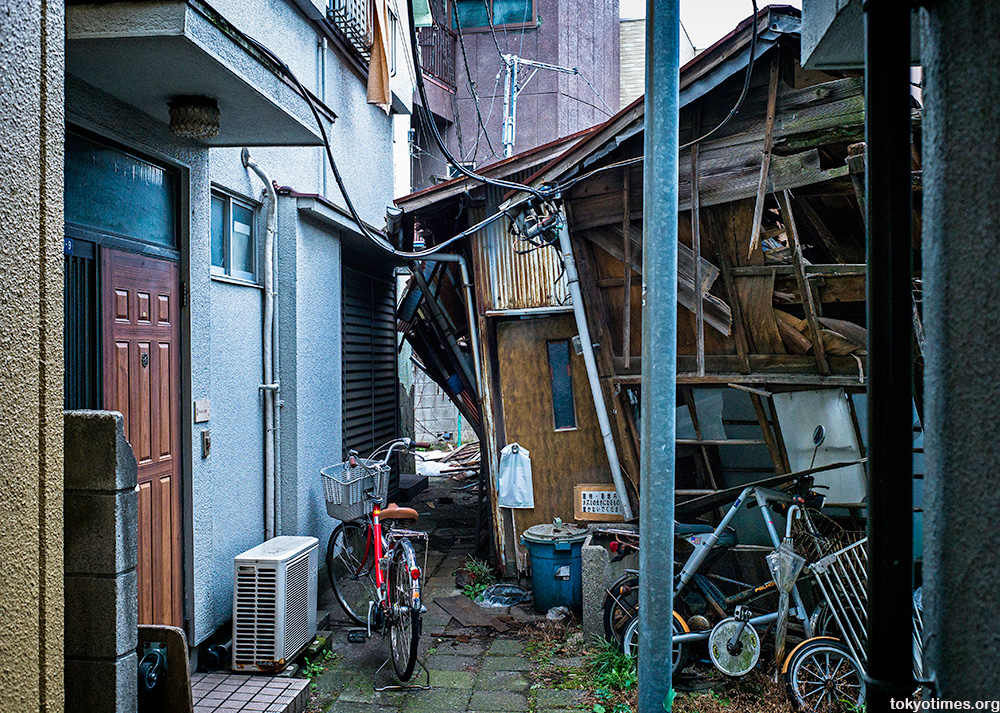Due to Japan’s ageing population and the continuing migration to the country’s large cities, it’s not really surprising that an increasing amount of houses are now left empty, or in many cases, completely abandoned. Yet the actual number of homes in such a state perhaps is. In 2008 — the last time such statistics were calculated — the figure stood at 7.57 million dwellings, or 13% of the total number of houses. A tally that is now estimated at somewhere in the region of 18%, and is expected to rise to a staggering 24% by 2028.
But such places aren’t merely restricted to less populated areas. Far from it. A combination of land/property tax incentives, plus a change in building regulations after the post-war period when many ageing wooden homes were constructed, means it’s financially beneficial to leave a property standing, regardless of its condition. Something that probably explains the number of crumbling, ramshackle houses one can regularly see in Tokyo — particularly in the city’s older neighbourhoods. None of the many I’ve seen, however, come close to the shocking state of this semi-collapsed monstrosity. A truly awful eyesore for the neighbours, not to mention a structural concern, as it’s clearly only the modern building that is keeping the old one (sort of) upright.

Erin says
Wow. Does the city tear down these dilapidated houses?
Lee says
That doesn’t seem to be the case. As they are privately owned, I guess they don’t have he right to. Plus there’s the cost involved too.
hgdownunder says
Those old traditional wooden houses weren’t supposed to last more than 20 years in theory.
Lee says
Yeah, some of them are so patched up and run-down it’s unbelievable. Heaven knows what they are like to live in. Winter in particular must be horrendous.
Belle says
I’m curious as to how it looks from the street.
I’m surprised that a bureaucratic country like Japan doesn’t have some sort of building safety code. This house is clearly a danger to anyone nearby.
Lee says
It is odd that a country so fond of rules seems to do nothing about this kind of thing.
It’s actually just off a busy street, near a train station and supermarket/shopping area. And yeah, not exactly safe. Despite the support of the newer house, it’s hard to imagine it staying even semi-upright for much longer.
Marc says
Reminds me of Kurosawa’s “The Lower Depths”.
Lee says
Makes sense. It certainly doesn’t have the look of modern Japan. Or at least not the modern Japan that one usually sees in the media.
sullivan says
its so high rate, ageing population is a really big problem to Japan.
Lee says
It is. A problem that is only going to get worse too. Much worse.
Jeffrey says
In another life I was an “expert” on this. Japan’s housing laws, in spite of some improvements, still suck. The government almost never exercise eminent domain, which would be crucial to clearing, rationalizing and consolidating literally thousands of acres of urban space. In many cases, particularly like the picture you chose, simply clearing the derelict structure away would be beneficial to the neighborhood.
While Tokyo and most urban areas in central and western Honshu continue to grow, no one would argue that the cities wouldn’t benefit from more open space, even if it were only razing the remnants of a long abandoned house.
Lee says
I’m no expert, but you are quite right – a bit of extra space would be very welcome. Pretty sure those living near these eye sores would be very grateful if the government did something too.
Jimbo! says
This is a good read: http://nextcity.org/informalcity/entry/when-tokyo-was-a-slum
Lee says
Cheers! A really interesting read. Explains a lot.